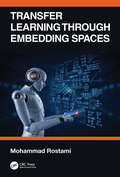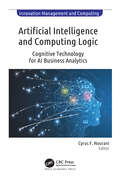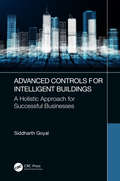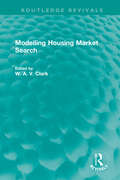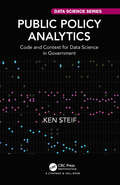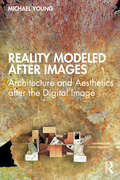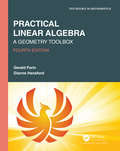- Table View
- List View
Serious Games in Personalized Learning: New Models for Design and Performance
by Scott M. Martin James R. Casey Stephanie KaneSerious Games in Personalized Learning investigates game-based teaching and learning at a time when learning and training systems are increasingly integrating serious games, machine-learning artificial intelligence models, and adaptive technologies. Game-based education provides rare data for measuring, assessing, and evaluating not just a game’s effectiveness but the acquisition of information and knowledge that a student may gain through playing a learning game. This book synthesizes contemporary research, frameworks, and models centered on the design and delivery of serious games that truly personalize the learning experience. Scholars of educational technology, instructional design, human performance, and more will find a comprehensive guide to the history, practical implications, and data-collection potential inherent to these fast-evolving tools.
Serious Games in Personalized Learning: New Models for Design and Performance
by Scott M. Martin James R. Casey Stephanie KaneSerious Games in Personalized Learning investigates game-based teaching and learning at a time when learning and training systems are increasingly integrating serious games, machine-learning artificial intelligence models, and adaptive technologies. Game-based education provides rare data for measuring, assessing, and evaluating not just a game’s effectiveness but the acquisition of information and knowledge that a student may gain through playing a learning game. This book synthesizes contemporary research, frameworks, and models centered on the design and delivery of serious games that truly personalize the learning experience. Scholars of educational technology, instructional design, human performance, and more will find a comprehensive guide to the history, practical implications, and data-collection potential inherent to these fast-evolving tools.
SRv6 Network Programming: Ushering in a New Era of IP Networks (Data Communication Series)
by Cheng Li Zhenbin Li Zhibo HuSRv6 Network Programming, beginning with the challenges for Internet Protocol version 6 (IPv6) network development, describes the background, roadmap design, and implementation of Segment Routing over IPv6 (SRv6), as well as the application of this technology in traditional and emerging services. The book begins with the development of IP technologies by focusing on the problems encountered during MPLS and IPv6 network development, giving readers insights into the problems tackled by SRv6 and the value of SRv6. It then goes on to explain SRv6 fundamentals, including SRv6 packet header design, the packet forwarding process, protocol extensions such as Interior Gateway Protocol (IGP), Border Gateway Protocol (BGP), and Path Computation Element Protocol (PCEP) extensions, and how SRv6 supports existing traffic engineering (TE), virtual private networks (VPN), and reliability requirements. Next, SRv6 network deployment is introduced, covering the evolution paths from existing networks to SRv6 networks, SRv6 network deployment processes, involved O&M technologies, and emerging 5G and cloud services supported by SRv6. Bit Index Explicit Replication IPv6 encapsulation (BIERv6), an SRv6 multicast technology, is then introduced as an important supplement to SRv6 unicast technology. The book concludes with a summary of the current status of the SRv6 industry and provides an outlook for new SRv6-based technologies. SRv6 Network Programming: Ushering in a New Era of IP Networks collects the research results of Huawei SRv6 experts and reflects the latest development direction of SRv6. With rich, clear, practical, and easy-to-understand content, the volume is intended for network planning engineers, technical support engineers and network administrators who need a grasp of the most cutting-edge IP network technology. It is also intended for communications network researchers in scientific research institutions and universities. Authors: Zhenbin Li is the Chief Protocol Expert of Huawei and member of the IETF IAB, responsible for IP protocol research and standards promotion at Huawei. Zhibo Hu is a Senior Huawei Expert in SR and IGP, responsible for SR and IGP planning and innovation. Cheng Li is a Huawei Senior Pre-research Engineer and IP standards representative, responsible for Huawei's SRv6 research and standardization.
SRv6 Network Programming: Ushering in a New Era of IP Networks (Data Communication Series)
by Cheng Li Zhenbin Li Zhibo HuSRv6 Network Programming, beginning with the challenges for Internet Protocol version 6 (IPv6) network development, describes the background, roadmap design, and implementation of Segment Routing over IPv6 (SRv6), as well as the application of this technology in traditional and emerging services. The book begins with the development of IP technologies by focusing on the problems encountered during MPLS and IPv6 network development, giving readers insights into the problems tackled by SRv6 and the value of SRv6. It then goes on to explain SRv6 fundamentals, including SRv6 packet header design, the packet forwarding process, protocol extensions such as Interior Gateway Protocol (IGP), Border Gateway Protocol (BGP), and Path Computation Element Protocol (PCEP) extensions, and how SRv6 supports existing traffic engineering (TE), virtual private networks (VPN), and reliability requirements. Next, SRv6 network deployment is introduced, covering the evolution paths from existing networks to SRv6 networks, SRv6 network deployment processes, involved O&M technologies, and emerging 5G and cloud services supported by SRv6. Bit Index Explicit Replication IPv6 encapsulation (BIERv6), an SRv6 multicast technology, is then introduced as an important supplement to SRv6 unicast technology. The book concludes with a summary of the current status of the SRv6 industry and provides an outlook for new SRv6-based technologies. SRv6 Network Programming: Ushering in a New Era of IP Networks collects the research results of Huawei SRv6 experts and reflects the latest development direction of SRv6. With rich, clear, practical, and easy-to-understand content, the volume is intended for network planning engineers, technical support engineers and network administrators who need a grasp of the most cutting-edge IP network technology. It is also intended for communications network researchers in scientific research institutions and universities. Authors: Zhenbin Li is the Chief Protocol Expert of Huawei and member of the IETF IAB, responsible for IP protocol research and standards promotion at Huawei. Zhibo Hu is a Senior Huawei Expert in SR and IGP, responsible for SR and IGP planning and innovation. Cheng Li is a Huawei Senior Pre-research Engineer and IP standards representative, responsible for Huawei's SRv6 research and standardization.
Analysis of Medical Modalities for Improved Diagnosis in Modern Healthcare
by Varun Bajaj G. R. SinhaIn modern healthcare, various medical modalities play an important role in improving the diagnostic performance in healthcare systems for various applications, such as prosthesis design, surgical implant design, diagnosis and prognosis, and detection of abnormalities in the treatment of various diseases. Analysis of Medical Modalities for Improved Diagnosis in Modern Healthcare discusses the uses of analysis, modeling, and manipulation of modalities, such as EEG, ECG, EMG, PCG, EOG, MRI, and FMRI, for an automatic identification, classification, and diagnosis of different types of disorders and physiological states. The analysis and applications for post-processing and diagnosis are much-needed topics for researchers and faculty members all across the world in the field of automated and efficient diagnosis using medical modalities. To meet this need, this book emphasizes real-time challenges in medical modalities for a variety of applications for analysis, classification, identification, and diagnostic processes of healthcare systems. Each chapter starts with the introduction, need and motivation of the medical modality, and a number of applications for the identification and improvement of healthcare systems. The chapters can be read independently or consecutively by research scholars, graduate students, faculty members, and practicing scientists who wish to explore various disciplines of healthcare systems, such as computer sciences, medical sciences, and biomedical engineering. This book aims to improve the direction of future research and strengthen research efforts of healthcare systems through analysis of behavior, concepts, principles, and case studies. This book also aims to overcome the gap between usage of medical modalities and healthcare systems. Several novel applications of medical modalities have been unlocked in recent years, therefore new applications, challenges, and solutions for healthcare systems are the focus of this book.
Analysis of Medical Modalities for Improved Diagnosis in Modern Healthcare
by Varun Bajajand G. R. SinhaIn modern healthcare, various medical modalities play an important role in improving the diagnostic performance in healthcare systems for various applications, such as prosthesis design, surgical implant design, diagnosis and prognosis, and detection of abnormalities in the treatment of various diseases. Analysis of Medical Modalities for Improved Diagnosis in Modern Healthcare discusses the uses of analysis, modeling, and manipulation of modalities, such as EEG, ECG, EMG, PCG, EOG, MRI, and FMRI, for an automatic identification, classification, and diagnosis of different types of disorders and physiological states. The analysis and applications for post-processing and diagnosis are much-needed topics for researchers and faculty members all across the world in the field of automated and efficient diagnosis using medical modalities. To meet this need, this book emphasizes real-time challenges in medical modalities for a variety of applications for analysis, classification, identification, and diagnostic processes of healthcare systems. Each chapter starts with the introduction, need and motivation of the medical modality, and a number of applications for the identification and improvement of healthcare systems. The chapters can be read independently or consecutively by research scholars, graduate students, faculty members, and practicing scientists who wish to explore various disciplines of healthcare systems, such as computer sciences, medical sciences, and biomedical engineering. This book aims to improve the direction of future research and strengthen research efforts of healthcare systems through analysis of behavior, concepts, principles, and case studies. This book also aims to overcome the gap between usage of medical modalities and healthcare systems. Several novel applications of medical modalities have been unlocked in recent years, therefore new applications, challenges, and solutions for healthcare systems are the focus of this book.
Transfer Learning through Embedding Spaces
by Mohammad RostamiRecent progress in artificial intelligence (AI) has revolutionized our everyday life. Many AI algorithms have reached human-level performance and AI agents are replacing humans in most professions. It is predicted that this trend will continue and 30% of work activities in 60% of current occupations will be automated. This success, however, is conditioned on availability of huge annotated datasets to training AI models. Data annotation is a time-consuming and expensive task which still is being performed by human workers. Learning efficiently from less data is a next step for making AI more similar to natural intelligence. Transfer learning has been suggested a remedy to relax the need for data annotation. The core idea in transfer learning is to transfer knowledge across similar tasks and use similarities and previously learned knowledge to learn more efficiently. In this book, we provide a brief background on transfer learning and then focus on the idea of transferring knowledge through intermediate embedding spaces. The idea is to couple and relate different learning through embedding spaces that encode task-level relations and similarities. We cover various machine learning scenarios and demonstrate that this idea can be used to overcome challenges of zero-shot learning, few-shot learning, domain adaptation, continual learning, lifelong learning, and collaborative learning.
The Role of the Internet of Things (IoT) in Biomedical Engineering: Present Scenario and Challenges
by Sushree Bibhuprada B. Priyadarshini Devendra Kumar Sharma Rohit Sharma Korhan CengizThis volume introduces the key evolving applications of IoT in the medical field for patient care delivery through the usage of smart devices. It shows how IoT opens the door to a wealth of relevant healthcare information through real-time data analysis as well as testing, providing reliable and pragmatic data that yields enhanced solutions and discovery of previously undiscovered issues. This new volume discusses IoT devices that are deployed for enabling patient health tracking, various emergency issues, smart administration of patients, etc. It looks at the problems of cardiac analysis in e-healthcare, explores the employment of smart devices aimed for different patient issues, and examines the usage of Arduino kits where the data can be transferred to the cloud for internet-based uses. The volume also considers the roles of IoT in electroencephalography (EEG) and magnetic resonance imaging (MRI), which play significant roles in biomedical applications. This book also incorporates the use of IoT applications for smart wheelchairs, telemedicine, GPS positioning of heart patients, smart administration with drug tracking, and more.
Artificial Intelligence and Computing Logic: Cognitive Technology for AI Business Analytics (Innovation Management and Computing)
by Cyrus F. NouraniFocusing on the cutting-edge applications of AI cognitive computing from neuromorphic to quantum cognition as applied to AI business analytics, this new volume explores AI’s importance in managing cognitive processes along with ontological modeling concepts for venturing into new business frontiers. The volume presents a selection of significant new accomplishments in the areas of AI cognitive computing ranging from neurocognition perception and decision-making in the human brain—combining neurocognitive techniques and effective computing—to basic facial recognition computing models. Topics include: Agent neurocomputing techniques for facial expression recognition Computing haptic motion and ontology epistemic Characterizations of morph schemas for visual analytics Learning and perceptive computing Functional and structural neuroimaging modeling Observed links between facial recognition and affective emotional processes Interaction of cognitive and emotional processes during social decision-making Neurocognitive processing of emotional facial expressions in individuals Neurocognitive affective system for emotive robot androids Virtual reality-based affect adaptive neuromorphic computingExecutive surveys indicate that cognitive adoption is very important in business strategy for success and to remain competitive. Employing cognitive-based processes provides the way to get the right information in the right hands at the right time, which is the key to winning in the digital era and to driving business value that emphasizes competitive differentiation. Several chapters of the volume address the goal of using cognitive technology to improve search capabilities, to provide personalized customer service in business and in health and wellness, and to create better workflow management. Key features: Looks at the newest frontiers on very popular AI and analytics topics Discusses new techniques for visual analytics and data filtering Shows how AI and cognitive science merges with quantum neurocognitive computing Presents ontology models with ontology preservation data filtering techniques Provides a cross-transposition on AI and digitizations for business model innovationsArtificial Intelligence and Computing Logic: Cognitive Technology for AI Business Analytics is a valuable resource that informs businesses and other enterprises the value of artificial intelligence and computing logic applications.
Computational Fluid Dynamics and COMSOL Multiphysics: A Step-by-Step Approach for Chemical Engineers
by Ashish S. ChaurasiaThis textbook covers computational fluid dynamics simulation using COMSOL Multiphysics® Modeling Software in chemical engineering applications. In the volume, the COMSOL Multiphysics package is introduced and applied to solve typical problems in chemical reactors, transport processes, fluid flow, and heat and mass transfer. Inspired by the difficulties of introducing the use of COMSOL Multiphysics software during classroom time, the book incorporates the author’s experience of working with undergraduate, graduate, and postgraduate students to make the book user friendly and that, at the same time, addresses typical examples within the subjects covered in the chemical engineering curriculum. Real-world problems require the use of simulation and optimization tools, and this volume shows how COMSOL Multiphysics software can be used for that purpose. Key features:• Includes over 500 step-by-step screenshots• Shows the graphical user interface of COMSOL, which does not require any programming effort• Provides chapter-end problems for extensive practice along with solutions• Includes actual examples of chemical reactors, transport processes, fluid flow, and heat and mass transfer This book is intended for students who want or need more help to solve chemical engineering assignments using computer software. It can also be used for computational courses in chemical engineering. It will also be a valuable resource for professors, research scientists, and practicing engineers.
Transfer Learning through Embedding Spaces
by Mohammad RostamiRecent progress in artificial intelligence (AI) has revolutionized our everyday life. Many AI algorithms have reached human-level performance and AI agents are replacing humans in most professions. It is predicted that this trend will continue and 30% of work activities in 60% of current occupations will be automated. This success, however, is conditioned on availability of huge annotated datasets to training AI models. Data annotation is a time-consuming and expensive task which still is being performed by human workers. Learning efficiently from less data is a next step for making AI more similar to natural intelligence. Transfer learning has been suggested a remedy to relax the need for data annotation. The core idea in transfer learning is to transfer knowledge across similar tasks and use similarities and previously learned knowledge to learn more efficiently. In this book, we provide a brief background on transfer learning and then focus on the idea of transferring knowledge through intermediate embedding spaces. The idea is to couple and relate different learning through embedding spaces that encode task-level relations and similarities. We cover various machine learning scenarios and demonstrate that this idea can be used to overcome challenges of zero-shot learning, few-shot learning, domain adaptation, continual learning, lifelong learning, and collaborative learning.
The Role of the Internet of Things (IoT) in Biomedical Engineering: Present Scenario and Challenges
by Sushree Bibhuprada B. PriyadarshiniThis volume introduces the key evolving applications of IoT in the medical field for patient care delivery through the usage of smart devices. It shows how IoT opens the door to a wealth of relevant healthcare information through real-time data analysis as well as testing, providing reliable and pragmatic data that yields enhanced solutions and discovery of previously undiscovered issues. This new volume discusses IoT devices that are deployed for enabling patient health tracking, various emergency issues, smart administration of patients, etc. It looks at the problems of cardiac analysis in e-healthcare, explores the employment of smart devices aimed for different patient issues, and examines the usage of Arduino kits where the data can be transferred to the cloud for internet-based uses. The volume also considers the roles of IoT in electroencephalography (EEG) and magnetic resonance imaging (MRI), which play significant roles in biomedical applications. This book also incorporates the use of IoT applications for smart wheelchairs, telemedicine, GPS positioning of heart patients, smart administration with drug tracking, and more.
Artificial Intelligence and Computing Logic: Cognitive Technology for AI Business Analytics (Innovation Management and Computing)
by Cyrus F. NouraniFocusing on the cutting-edge applications of AI cognitive computing from neuromorphic to quantum cognition as applied to AI business analytics, this new volume explores AI’s importance in managing cognitive processes along with ontological modeling concepts for venturing into new business frontiers. The volume presents a selection of significant new accomplishments in the areas of AI cognitive computing ranging from neurocognition perception and decision-making in the human brain—combining neurocognitive techniques and effective computing—to basic facial recognition computing models. Topics include: Agent neurocomputing techniques for facial expression recognition Computing haptic motion and ontology epistemic Characterizations of morph schemas for visual analytics Learning and perceptive computing Functional and structural neuroimaging modeling Observed links between facial recognition and affective emotional processes Interaction of cognitive and emotional processes during social decision-making Neurocognitive processing of emotional facial expressions in individuals Neurocognitive affective system for emotive robot androids Virtual reality-based affect adaptive neuromorphic computingExecutive surveys indicate that cognitive adoption is very important in business strategy for success and to remain competitive. Employing cognitive-based processes provides the way to get the right information in the right hands at the right time, which is the key to winning in the digital era and to driving business value that emphasizes competitive differentiation. Several chapters of the volume address the goal of using cognitive technology to improve search capabilities, to provide personalized customer service in business and in health and wellness, and to create better workflow management. Key features: Looks at the newest frontiers on very popular AI and analytics topics Discusses new techniques for visual analytics and data filtering Shows how AI and cognitive science merges with quantum neurocognitive computing Presents ontology models with ontology preservation data filtering techniques Provides a cross-transposition on AI and digitizations for business model innovationsArtificial Intelligence and Computing Logic: Cognitive Technology for AI Business Analytics is a valuable resource that informs businesses and other enterprises the value of artificial intelligence and computing logic applications.
Computational Fluid Dynamics and COMSOL Multiphysics: A Step-by-Step Approach for Chemical Engineers
by Ashish S. ChaurasiaThis textbook covers computational fluid dynamics simulation using COMSOL Multiphysics® Modeling Software in chemical engineering applications. In the volume, the COMSOL Multiphysics package is introduced and applied to solve typical problems in chemical reactors, transport processes, fluid flow, and heat and mass transfer. Inspired by the difficulties of introducing the use of COMSOL Multiphysics software during classroom time, the book incorporates the author’s experience of working with undergraduate, graduate, and postgraduate students to make the book user friendly and that, at the same time, addresses typical examples within the subjects covered in the chemical engineering curriculum. Real-world problems require the use of simulation and optimization tools, and this volume shows how COMSOL Multiphysics software can be used for that purpose. Key features:• Includes over 500 step-by-step screenshots• Shows the graphical user interface of COMSOL, which does not require any programming effort• Provides chapter-end problems for extensive practice along with solutions• Includes actual examples of chemical reactors, transport processes, fluid flow, and heat and mass transfer This book is intended for students who want or need more help to solve chemical engineering assignments using computer software. It can also be used for computational courses in chemical engineering. It will also be a valuable resource for professors, research scientists, and practicing engineers.
Advanced Controls for Intelligent Buildings: A Holistic Approach for Successful Businesses
by Siddharth GoyalThis book focuses primarily on both technical and business aspects needed to select, design, develop and deploy control application (or product) successfully for multiple components in building systems. Designing and deploying a control application require multiple steps such as sensing, system dynamics modelling, algorithms, and testing. This may involve choosing an appropriate methodology and technique at multiple stages during the development process. Understanding the pros and cons of such techniques, most importantly being aware of practically possible approaches in the entire ecosystem, is critical in choosing the best framework and system application for different parts of building systems. Providing a wide overview of the state-of art in controls and building systems, providing guidance on developing an end-to-end system in relation to business fundamentals (distribution channels, stakeholders, marketing, supply-chain and financial management), the book is ideal for fourth-year control/mechanical/electrical engineering undergraduates, graduate students, and practitioners including business leaders concerned with smart building technology.
Advanced Controls for Intelligent Buildings: A Holistic Approach for Successful Businesses
by Siddharth GoyalThis book focuses primarily on both technical and business aspects needed to select, design, develop and deploy control application (or product) successfully for multiple components in building systems. Designing and deploying a control application require multiple steps such as sensing, system dynamics modelling, algorithms, and testing. This may involve choosing an appropriate methodology and technique at multiple stages during the development process. Understanding the pros and cons of such techniques, most importantly being aware of practically possible approaches in the entire ecosystem, is critical in choosing the best framework and system application for different parts of building systems. Providing a wide overview of the state-of art in controls and building systems, providing guidance on developing an end-to-end system in relation to business fundamentals (distribution channels, stakeholders, marketing, supply-chain and financial management), the book is ideal for fourth-year control/mechanical/electrical engineering undergraduates, graduate students, and practitioners including business leaders concerned with smart building technology.
Innovative and Intelligent Technology-Based Services For Smart Environments - Smart Sensing and Artificial Intelligence: Proceedings of the 2nd International Conference on Smart Innovation, Ergonomics and Applied Human Factors (SEAHF’20), held online, 14-15 November 2020
by Sami Ben Slama Fethi Choubani Cesar Benavente-Peces Afef AbdelkarimThis book contains a collection of high-quality papers describing the results of relevant investigations and cutting-edge technologies, aimed at improving key aspects of real life, including major challenges such as the development of smart cities, smart buildings, smart grids, and the reduction of the impact of human activities on the environment. Sustainability requires the use of green technologies and techniques and good practices. Artificial intelligence seems to be an appropriate approach to optimize the use of resources. The main focus of this book is the dissemination of novel and innovative technologies, techniques and applications of artificial intelligence, computing and information and communications technologies, and new digital services such as digital marketing, smart tourism, smart agriculture, green and renewable energy sources. Besides, this book focuses on nurturing energy trends including renewable energies, smart grids, human activity impact, communication, behaviour, and social development, and quality of life improvement fields based on the innovative use of sensors, big data and the Internet of things (IoT), telecommunications and machine learning.
Innovative and Intelligent Technology-Based Services For Smart Environments - Smart Sensing and Artificial Intelligence: Proceedings of the 2nd International Conference on Smart Innovation, Ergonomics and Applied Human Factors (SEAHF’20), held online, 14-15 November 2020
by Sami Ben SlamaThis book contains a collection of high-quality papers describing the results of relevant investigations and cutting-edge technologies, aimed at improving key aspects of real life, including major challenges such as the development of smart cities, smart buildings, smart grids, and the reduction of the impact of human activities on the environment. Sustainability requires the use of green technologies and techniques and good practices. Artificial intelligence seems to be an appropriate approach to optimize the use of resources. The main focus of this book is the dissemination of novel and innovative technologies, techniques and applications of artificial intelligence, computing and information and communications technologies, and new digital services such as digital marketing, smart tourism, smart agriculture, green and renewable energy sources. Besides, this book focuses on nurturing energy trends including renewable energies, smart grids, human activity impact, communication, behaviour, and social development, and quality of life improvement fields based on the innovative use of sensors, big data and the Internet of things (IoT), telecommunications and machine learning.
Modelling Housing Market Search (Routledge Revivals)
by William A. V. ClarkOriginally published in 1982, this book contains research in the area of econometric modelling in the housing market, including that which has extended to the use of search models. The subjects covered include the importance of racial differences, spatial aspects of residential search and information provision and its effect on the behaviour of the buyers. The combination of careful analytic modelling, empirical testing and speculative discussions of the role of agents in the search process provides an innovative and imaginative approach to the interesting problems of understanding the individual behaviour in complex contexts such as the urban housing market.
Modelling Housing Market Search (Routledge Revivals)
by W. A. V. ClarkOriginally published in 1982, this book contains research in the area of econometric modelling in the housing market, including that which has extended to the use of search models. The subjects covered include the importance of racial differences, spatial aspects of residential search and information provision and its effect on the behaviour of the buyers. The combination of careful analytic modelling, empirical testing and speculative discussions of the role of agents in the search process provides an innovative and imaginative approach to the interesting problems of understanding the individual behaviour in complex contexts such as the urban housing market.
Public Policy Analytics: Code and Context for Data Science in Government (Chapman & Hall/CRC Data Science Series)
by Ken SteifPublic Policy Analytics: Code & Context for Data Science in Government teaches readers how to address complex public policy problems with data and analytics using reproducible methods in R. Each of the eight chapters provides a detailed case study, showing readers: how to develop exploratory indicators; understand ‘spatial process’ and develop spatial analytics; how to develop ‘useful’ predictive analytics; how to convey these outputs to non-technical decision-makers through the medium of data visualization; and why, ultimately, data science and ‘Planning’ are one and the same. A graduate-level introduction to data science, this book will appeal to researchers and data scientists at the intersection of data analytics and public policy, as well as readers who wish to understand how algorithms will affect the future of government.
Public Policy Analytics: Code and Context for Data Science in Government (Chapman & Hall/CRC Data Science Series)
by Ken SteifPublic Policy Analytics: Code & Context for Data Science in Government teaches readers how to address complex public policy problems with data and analytics using reproducible methods in R. Each of the eight chapters provides a detailed case study, showing readers: how to develop exploratory indicators; understand ‘spatial process’ and develop spatial analytics; how to develop ‘useful’ predictive analytics; how to convey these outputs to non-technical decision-makers through the medium of data visualization; and why, ultimately, data science and ‘Planning’ are one and the same. A graduate-level introduction to data science, this book will appeal to researchers and data scientists at the intersection of data analytics and public policy, as well as readers who wish to understand how algorithms will affect the future of government.
Reality Modeled After Images: Architecture and Aesthetics after the Digital Image
by Michael YoungReality Modeled After Images: Architecture and Aesthetics after the Digital Image explores architecture’s entanglement with contemporary image culture. It looks closely at how changes produced through technologies of mediation alter disciplinary concepts and produce political effects. Through both historical and contemporary examples, it focuses on how conventions of representation are established, maintained, challenged, and transformed. Critical investigations are conjoined with inquiries into aesthetics and technology in the hope that the tensions between them can aid an exploration into how architectural images are produced, disseminated, and valued; how images alter assumptions regarding the appearances of architecture and the environment.For students and academics in architecture, design and media studies, architectural and art history, and related fields, this book shows how design is impacted and changed by shifts in image culture, representational conventions and technologies.
Reality Modeled After Images: Architecture and Aesthetics after the Digital Image
by Michael YoungReality Modeled After Images: Architecture and Aesthetics after the Digital Image explores architecture’s entanglement with contemporary image culture. It looks closely at how changes produced through technologies of mediation alter disciplinary concepts and produce political effects. Through both historical and contemporary examples, it focuses on how conventions of representation are established, maintained, challenged, and transformed. Critical investigations are conjoined with inquiries into aesthetics and technology in the hope that the tensions between them can aid an exploration into how architectural images are produced, disseminated, and valued; how images alter assumptions regarding the appearances of architecture and the environment.For students and academics in architecture, design and media studies, architectural and art history, and related fields, this book shows how design is impacted and changed by shifts in image culture, representational conventions and technologies.
Practical Linear Algebra: A Geometry Toolbox (Textbooks in Mathematics)
by Gerald Farin Dianne HansfordLinear algebra is growing in importance. 3D entertainment, animations in movies and video games are developed using linear algebra. Animated characters are generated using equations straight out of this book. Linear algebra is used to extract knowledge from the massive amounts of data generated from modern technology. The Fourth Edition of this popular text introduces linear algebra in a comprehensive, geometric, and algorithmic way. The authors start with the fundamentals in 2D and 3D, then move on to higher dimensions, expanding on the fundamentals and introducing new topics, which are necessary for many real-life applications and the development of abstract thought. Applications are introduced to motivate topics. The subtitle, A Geometry Toolbox, hints at the book’s geometric approach, which is supported by many sketches and figures. Furthermore, the book covers applications of triangles, polygons, conics, and curves. Examples demonstrate each topic in action. This practical approach to a linear algebra course, whether through classroom instruction or self-study, is unique to this book. New to the Fourth Edition: Ten new application sections. A new section on change of basis. This concept now appears in several places. Chapters 14-16 on higher dimensions are notably revised. A deeper look at polynomials in the gallery of spaces. Introduces the QR decomposition and its relevance to least squares. Similarity and diagonalization are given more attention, as are eigenfunctions. A longer thread on least squares, running from orthogonal projections to a solution via SVD and the pseudoinverse. More applications for PCA have been added. More examples, exercises, and more on the kernel and general linear spaces. A list of applications has been added in Appendix A. The book gives instructors the option of tailoring the course for the primary interests of their students: mathematics, engineering, science, computer graphics, and geometric modeling.



